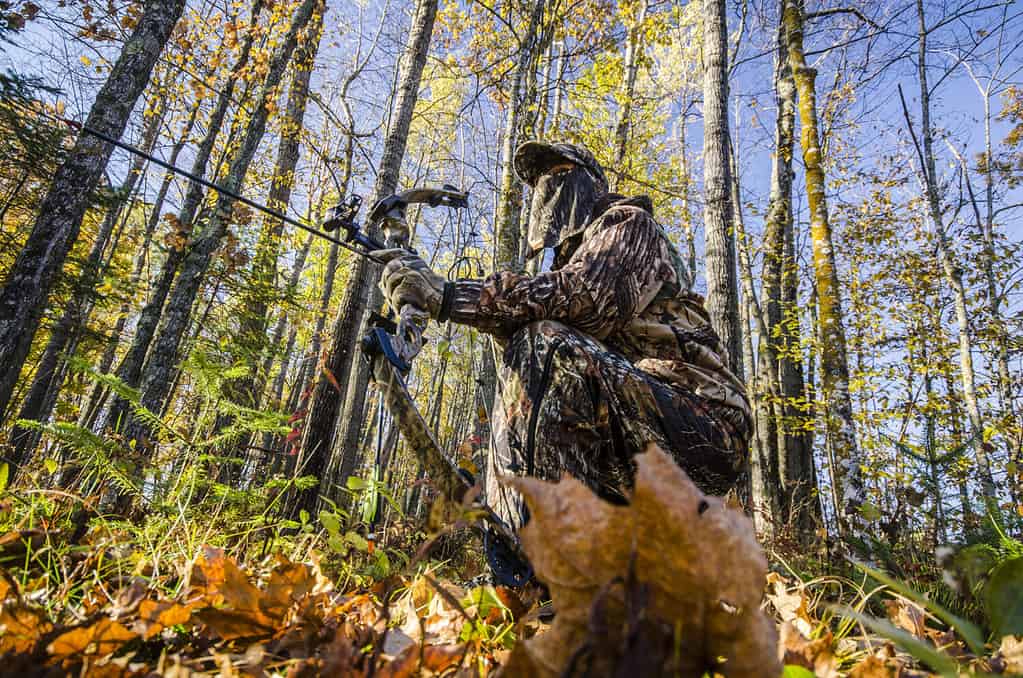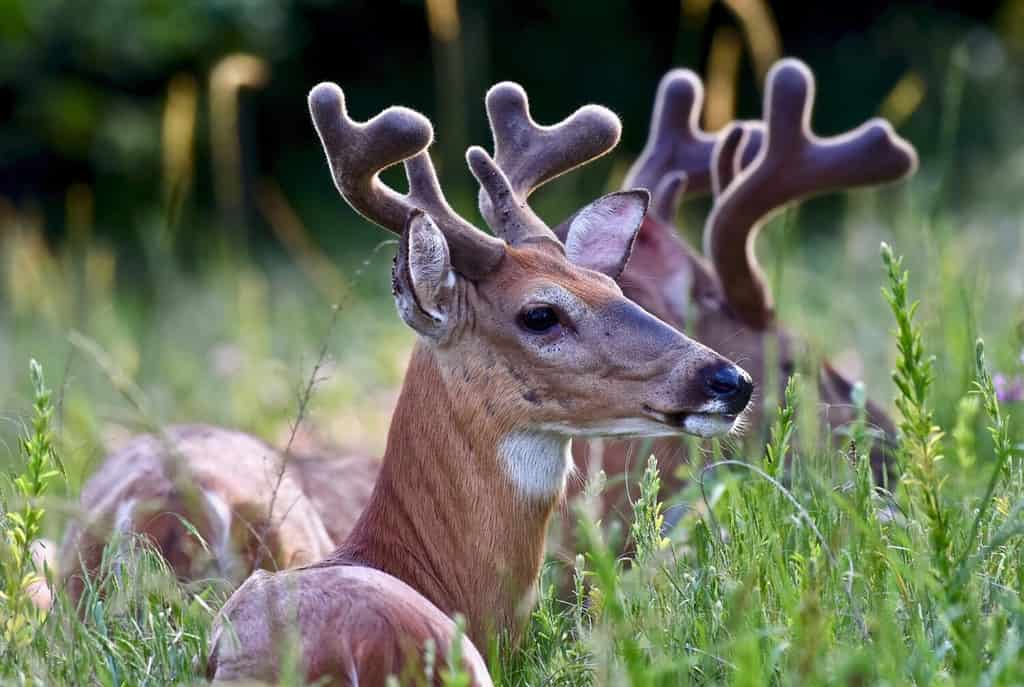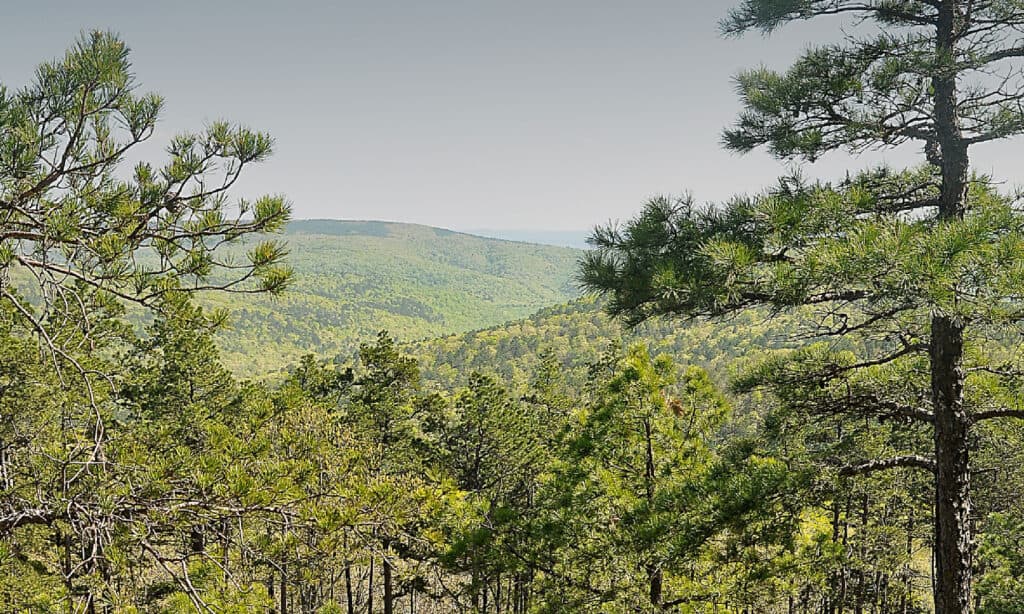Controlled deer hunting can be beneficial to the regional deer population as well as native vegetation. Preventing the deer population from growing too large ensures enough food for the deer. Because, if there’s a low food supply, that means many deer will face starvation. Plus, a huge deer population can prevent other plants and crops from reproducing abundantly. By utilizing controlled hunting, deer populations are kept in check, ensuring a balanced ecosystem. Oklahoma makes it fairly easy for deer hunters to participate in the hunting season. Here are six reasons why Oklahoma is the best state for deer hunting.
#1 Abundant Deer Population

Female white-tailed deer produce one litter yearly with 1 to 3 fawns, but usually 2. First-time mothers usually give birth to just one fawn.
©Tom Reichner/Shutterstock.com
Although Oklahoma isn’t the state with the most white-tailed deer (that would be Texas), it is still in the top 20. With 750,000 white-tailed deer in the state and 2,375 mule deer, there is a good chance you will be bringing home a deer.
In the 2022-2023 hunting season, the Oklahoma Department of Wildlife Conservation said preliminary numbers show hunters caught 128,796 deer.
#2 Affordable Licenses and Tags

Male white-tailed deer attain maturity the second breeding season after birth, or at about 18 months.
©Tom Reichner/Shutterstock.com
Licenses available to Oklahoma residents include annual licenses, licenses valid for five years, or lifetime licenses.
Adults (over 18 years of age) who are residents of Oklahoma must purchase a Resident Annual Hunting License ($32) or a Resident Combination Hunting/Fishing License ($53). The Resident 5-Year Hunting License is $88, and the Lifetime Hunting License is $625. Only 32 states offer lifetime hunting licenses.
Residents between the ages of 16 and 17 must buy either a Resident Youth Hunting License ($7) or a Resident Youth Combination Hunting/Fishing License ($19).
Hunters who do not call Oklahoma home must buy an Oklahoma non-resident license, either an annual ($176) or a five-day hunting license ($75) for non-residents.
In addition, hunters must buy a specific deer license to hunt in Oklahoma. For adult residents 18 and older, there are Resident Deer Archery, Resident Deer Muzzleloader (Antlered and Antlerless), and Resident Deer Gun (Antlered and Antlerless) licenses.
There are youth versions of these deer licenses that hunters under 18 must purchase, as well as non-resident versions that are required for out-of-state hunters. To read about all the available licenses and prices, visit the Oklahoma Department of Wildlife Conservation website.
#3 Long Archery Hunting Season

Often, archery seasons are much longer because the chances of success are much lower.
©paul geilfuss/Shutterstock.com
Typically, most states begin their deer hunting season either in the middle of September or early October. Oklahoma’s archery season begins October 1st. But instead of closing at the end of the year like many states, Oklahoma’s archery extends until January 15th. Of course, exact days may change based on the Oklahoma Department of Wildlife Conservation’s discretion. They need to adjust the season based on the breeding and weaning periods of the deer.
#4 No Instances of Chronic Wasting Disease

Chronic Wasting Disease spreads through direct animal-to-animal contact.
©moosehenderson/Shutterstock.com
As of 2022, Chronic Wasting Disease (CWD) has not been detected in Oklahoma. CWD is a fatal neurological disease that affects the brains of deer, elk, moose, and other members of the deer family (Cervidae). The disease makes the brain appear spongy, and some symptoms include weight loss and body decline, behavioral changes, excessive salivation, and, eventually, death.
The disease is spread through direct contact between animals. This can be through saliva, waste, or carcasses of infected animals. There is no known treatment or vaccine. While CWD doesn’t appear dangerous to humans, it is still unknown whether CWD can be transmitted to humans.
But if you hunt in Oklahoma, the risk of that is very low. The closest occurrence of a CWD-infected deer in Oklahoma was in 2022, which was 2.5 miles south of the border in Texas.
#5 Antler Size

White-tailed deer grow velvet on their antlers throughout the spring and summer months and shed them generally sometime in mid-August.
©Jeramey Lende/Shutterstock.com
You can find white-tailed deer in all 77 counties of Oklahoma. While the deer mostly congregate in the bottomland forests and upland hardwoods, the prairie and shrublands are habitable. All in all, the landscape in Oklahoma is a place where deer thrive.
The National Deer Association’s 2020 Annual Report in Oklahoma found that 66 percent of the bucks harvested in 2017 and 2018 were 3 ½ years old or older. While antler size doesn’t necessarily indicate the deer’s age, but rather, the health and fitness of the deer, white-tailed deer have the largest antlers between four and six years old.
So, according to the report, many hunters were able to get bucks in the age class that sees peak antler growth. And, because of the sustainable environment, most of these deer are healthy and active, leading to large antler sizes. This is another reason why Oklahoma is the best state for deer hunting.
#6 A Large Amount of Public Land to Hunt On

The Oklahoma Land Access Program incentivizes private landowners to open their property to public hunting and fishing.
©iStock.com/Don Blakes Prairie Wind Photography
About 4.6 percent of Oklahoma is public land, and the state has over 932,000 acres for hunting. That encompasses national forests, grasslands, and 80 Wildlife Management Areas.
Also advantageous is the Oklahoma Land Access Program. Administered by the Oklahoma Department of Wildlife Conservation, the OLAP gives landowners financial incentives to allow the public to hunt, fish, or view wildlife on the landowner’s private land.
Summary of Deer Hunting in Oklahoma
Oklahoma is the best place to hunt deer. If you are ready to plan your next hunting trip to the Sooner State, check out everything you need to know for deer season in Oklahoma. In the meantime, here is a review of the six main reasons Oklahoma is the best place for deer hunting.
| Number | Reason Oklahoma Is the Best State to Deer Hunt |
|---|---|
| #1 | Abundant Deer Population |
| #2 | Affordable Licenses and Tags |
| #3 | Long Archery Hunting Season |
| #4 | No Instances of Chronic Wasting Disease |
| #5 | Antler Size |
| #6 | A Large Amount of Public Land to Hunt On |
The photo featured at the top of this post is © Karel Bock/Shutterstock.com
Thank you for reading! Have some feedback for us? Contact the AZ Animals editorial team.







